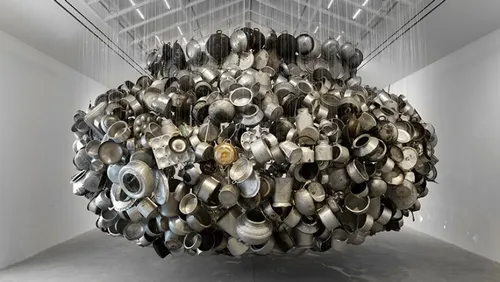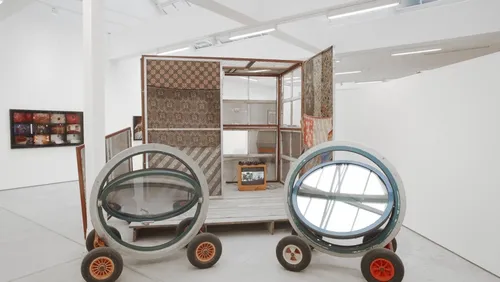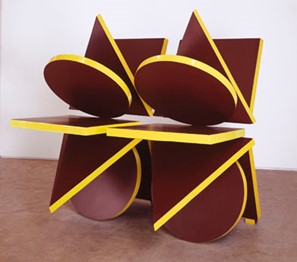Mead Gallery Exhibitions 2017
Subodh Gupta: From Far Away Uncle Moon Calls
Subodh Gupta Chanda Mama door ke (From Far Away Uncle Moon Calls) 2015 Found aluminium utensils, fish strings, steel Unique 274 x 487 x 487 cm Installation view: Subodh Gupta. Invisible Reality Hauser & Wirth Somerset, Somerset/UK February 12 - May 2, 2016 Photo: Ken Adlard Courtesy the artist and Hauser & Wirth
Sat 14 Jan – Sat 11 Mar 2017
The Mead Gallery presents a major exhibition by one of India’s foremost contemporary artists, Subodh Gupta.
Subodh Gupta is famous for transforming the everyday materials of Indian life into artworks. Working across painting, sculpture and installation, in Gupta’s hands objects such as tiffin boxes, cooking utensils and milk pails are used to reflect on the economic transformation of India during his lifetime and question the ambivalence of a society caught between traditional customs and globalisation, booming wealth and poverty. The artist’s work – beautiful, sensuous and frequently spectacular – encourages viewers to question the material, cultural and spiritual values attributed to objects, including pondering the inner life of used and discarded cooking vessels.
Subodh Gupta was born in Khagaul, Bihar, in India in 1964 and now lives and works in New Delhi. The artist has exhibited internationally at galleries including the National Gallery of Australia in Melbourne; the Victoria and Albert Museum, London; and the National Gallery of Modern Art in New Delhi. He is represented by Hauser & Wirth in Zurich, London, New York, Somerset and Los Angeles.
Room
Sat 6 May – Sat 24 Jun 2017
Room is an exhibition of installations, sculptures and photographs by international women artists, which variously explore ideas around architecture and the domestic environment – historically perceived as a female sphere of activity.
Curated by Laura Lord from Sadie Coles HQ, London, Room reflects the multiple, often concurrent, meanings and functions of the room. It represents work produced from the 1970s to present day, which envisage the room as an erotically charged or psychological space, alongside pieces which emphasise the structural or aesthetic properties of interior space.
Nan Goldin’s photographic series, Empty Rooms, Berlin/Hamburg (1983-96), taken in brothels, hotels and gay bars, speaks of absent human subjects and activities that have taken place there. Beverly Buchanan’s series of miniature houses (2009-12), roughly crafted out of wood, allude to shacks, cabins and other basic human dwellings, including those damaged by hurricanes. Heidi Bucher’s Herrenzimmer (1977-78) or ‘room skin’ is an installation made by moulding, in skin-like sheets of latex, the interior of her father’s study in the parental home. The exhibition also includes Cell XVII (Portrait) (2000) by Louise Bourgeois, in which a single elongated head is housed within a glass-fronted cage: a structure both protective and imprisoning. Together, such works depict the room as a tangible entity, rooted in a specific place and time, and yet charged with emotional and imaginative resonance.
A selection of visitor comments:
“Another stimulating exhibition brought to our area. Thank you to the curating and commissioning teams.”
“Great exhibition of great artists. Well balanced combination of 2D and 3D works. It is absolute pleasure to see artworks by Francesca Woodman, Louise Bourgeois and Heidi Bucher particularly.”
“Those artists have been researched for my dissertation and seeing the artworks in [the] flesh underpins what I have been looking for. The subject of femininity and domesticity is great moved to the public space of gallery from intimate sphere of home.”
“Fantastic, innovative, well curated! Sets in motion a thousand thoughts. Great work.”
“Eye-opener to so many of life’s varied aspects. Loved it. Thank you for hosting.”
“A fascinating exhibition, with a clear theme throughout all of the chosen works – Always enjoy visiting!”
“Really nice exhibition. The staff is really nice and kind! Thank you!”
“Great selection of works! Especially liked the Bourgeois and the Woodman.”
“Gave rise to an excellent discussion. Once we ‘got into’ the artwork the ore we saw and hopefully understood.”
“Evocative rooms – especially the shanty shacks, the Romanian kitchen + the Herrenzimmer. The idea of the homemade den was priceless – and fun!”
“Amazing selection of examples of work that touched the experiences of people + their living conditions, entertainment and work. I liked Penny Slinger’s surreal drama and Beverly Buchanan’s shanty town shacks. As a group we had plenty to discuss ad draw out opinions.”
“Concise theme, well presented. Especially liking the wooden houses and photography.”
“Just love the latex piece [by] Heidi Bucher – so lucky to see this! A friend saw the ‘Teenage Room’ & says it has helped her understand her 17 yr old son.
Kaleidoscope: Sequence and Colour in 1960s British Art
Philip King Point X 1965, fiberglass and polyester
5 October - 9 December 2017
British art of the 1960s is often noted for its bold, artificial colour, alluring surfaces and capricious shapes and forms, yet these exuberant qualities are often underpinned by a clearly apparent order, founded on repetition, sequence and symmetry. Bringing together exceptional examples of painting and sculpture from the Arts Council Collection, and augmented with major loans from important UK collections, Kaleidoscope examines the art of the 1960s through this fresh and surprising lens, one bringing into direct view the relationship between colour and form, rationality and irrationality, order and waywardness.
As the first Arts Council Collection survey of 1960s art in over twenty years, Kaleidoscope assumes a wide angle, looking across media and movements to find shared concerns and correspondences. From this perspective, the eye-boggling surfaces of Op, the flattened repeated figures of Pop, the mathematical order of Constructivism and the sequential placement of the brightly-coloured units found in New Generation sculpture begin to find a common language, one shaped by repetition and symmetry. The work stands in an international context, alongside Constantin Brancusi’s stacked volumetric blocks, Andy Warhol’s recurring mass-media imagery, and the repeated streamlined forms of American Minimalism.
Kaleidoscope represents the work of over twenty artists including David Annesley, Robyn Denny, Tess Jaray, Phillip King, Kim Lim, Jeremy Moon, Mary Martin, Bridget Riley, Tim Scott, Richard Smith, William Tucker and William Turnbull. Curated with the writer and curator, Sam Cornish, the exhibition offers fresh insight into a period of British art which has attracted surprisingly little critical attention. Beyond its art historical significance, the idea of repetition and symmetry is immediately accessible to a wide audience. Together the works create a visually arresting display and a feast of colour and form in the gallery.
The subject is ripe for interpretation and learning for all ages, with much scope for schools to apply the work to a range of subject areas within the National Curriculum. The exhibition will be accompanied by a range of educational activities for use in the gallery. Downloadable resources, including a teacher’s pack and a film, will also be available.
Kaleidoscope will be accompanied by a fully illustrated book produced by Hayward Publishing and the exhibition will launch at Longside Gallery, Yorkshire Sculpture Park in spring 2017 before touring to three subsequent venues. There is scope to tailor the selection to suit venues of a range of sizes and for selections to complement permanent collections at venues. Availability is as follows, with some flexibility regarding dates:
The Arts Council Collection is the largest national loan collection of modern and contemporary British art in the world. It is the most widely circulated of all of Britain's national collections and can be seen in exhibitions in museums, galleries and public spaces across the UK and abroad. The Arts Council Collection supports artists based in the UK through the purchase and display of their work. Since it was founded in 1946, the Collection's acquisitions policy has always been characterised by a spirit of risk-taking combined with an informed appraisal of current practice.
Sam Cornish is a writer on abstract art and a curator. Recent projects include a book and exhibition on the artists who worked at the Stockwell Depot, a monograph and exhibition on the UK/NZ sculptor John Panting, and the editorship of a two-volume survey of the paintings of Gary Wragg. Cornish has organised the symposia ‘Collaborating with Caro’ and ‘Colour, Emotion, Non-Figuration: John Hoyland Re-Visited’. He is currently working on the John Hoyland catalogue raisonné, a monograph on the sculptor Tim Scott and a book and exhibition on the vertical sculptures of Peter Hide. From 2012 to 2014 Cornish was editor of www.abstractcritical.com, and he currently contributes reviews to Studio International.
All works: Arts Council Collection, Southbank Centre, London.



